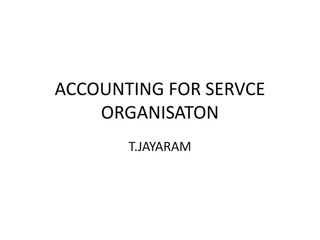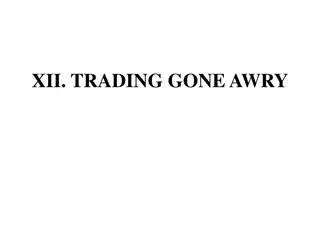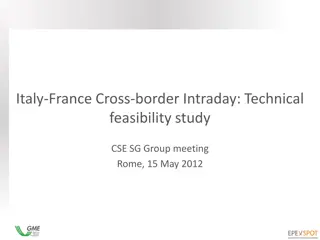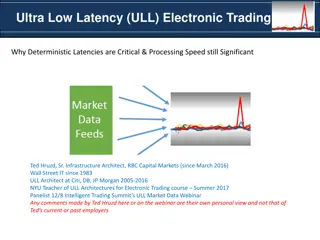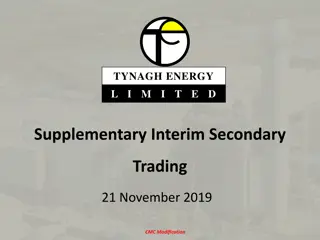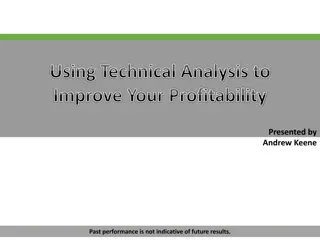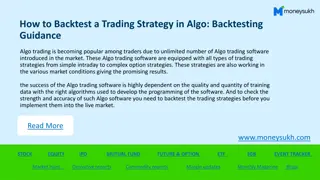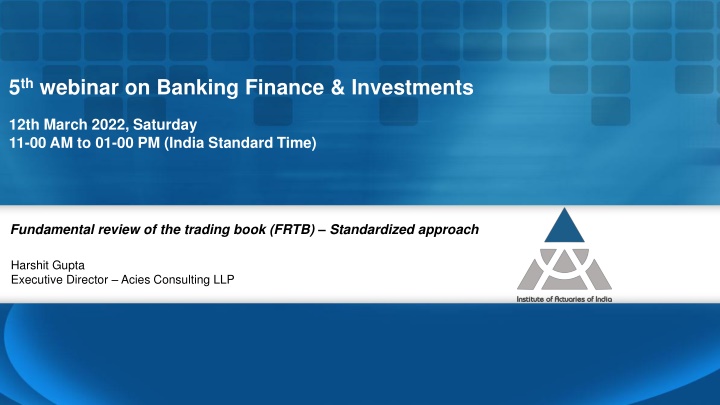
Fundamental Review of the Trading Book (FRTB) Standardized Approach
Join Harshit Gupta, Executive Director at Acies Consulting LLP, for the 5th webinar on Banking, Finance, and Investments. The webinar will cover topics such as market risk, capital requirements under Basel, FRTB, and more. Harshit Gupta brings extensive experience in risk and finance, working with financial institutions and large corporates across 5 countries. Don't miss this opportunity to gain insights into key aspects of the trading book and market risk management.
Download Presentation

Please find below an Image/Link to download the presentation.
The content on the website is provided AS IS for your information and personal use only. It may not be sold, licensed, or shared on other websites without obtaining consent from the author. If you encounter any issues during the download, it is possible that the publisher has removed the file from their server.
You are allowed to download the files provided on this website for personal or commercial use, subject to the condition that they are used lawfully. All files are the property of their respective owners.
The content on the website is provided AS IS for your information and personal use only. It may not be sold, licensed, or shared on other websites without obtaining consent from the author.
E N D
Presentation Transcript
5th webinar on Banking Finance & Investments 12th March 2022, Saturday 11-00 AM to 01-00 PM (India Standard Time) Fundamental review of the trading book (FRTB) Standardized approach Harshit Gupta Executive Director Acies Consulting LLP
Speaker Profile Harshit Gupta, Executive Director Acies Executive Director at Acies (www.acies.consulting) a technology and advisory firm based out of Mumbai having a global presence spanning across 5 countries. Leads Risk and Finance business at Acies working back with Financial Institutions, Large Corporates. Responsible for Kepler credit risk management and Kore market and treasury management products for Acies Worked on a diverse set of risk and technology engagements in areas such as market and credit risk, IFRS 9, 13, derivative valuation, capital computations Working back with 17 life insurance companies in India on their Interest rate risk management framework using derivative products allowed by the regulator www.actuariesindia.org
Agenda Overview of market risk Drivers of market risk Sources of market risk for a bank Capital requirements for market risk under Basel Fundamental Review of the Trading Book (FRTB) Boundary between trading and banking books Standardized approach Sensitivity Based Approach Default Risk Charge Residual Risk Add-on Q/A
Typical balance sheet of a Financial Institutions Figures in million Assets contributing to market risk These are on-balancesheet assets that contribute to market risk and are required to be managed. The question remains are these the only assets? www.actuariesindia.org
Typical balance sheet of a Financial Institutions Figures in billion Off balance sheet items Typical instruments Interest Rate Swaps Currency Swaps Interest Rate, Equity, Commodity Options Forwards, Spot, Futures Equity Swaps 47,000 billion off-balancesheet derivative exposure compared to 3,700 on-balancesheet exposures www.actuariesindia.org
Operational flow for market risk management Regulations and Internal policies Front office Middle & Back office Methodologies Governance & Accounting & settlement Model validation Model calibration parameters Limit mgmt. & reporting Valuation & risk quantification Market data Trades Policy desk Model results and outputs Market risk models Pricing and valuation Risk Stress testing Scenarios Market risk Capital sensitivities Market risk system www.actuariesindia.org
Overview of market risk Market risk is the risk associated with the effect of changes in market factors, such as interest and foreign exchange rates, equity and commodity prices, credit spreads or implied volatilities, on the value of assets and liabilities held for both the short and long term. Credit spread risk Default risk Interest rate risk Equity risk Commod ity risk Trading book FX risk Commod ity risk Banking book FX risk Banks are required to keep capital aside to protect themselves against such risks www.actuariesindia.org
Drivers of market risk Equity prices Credit spreads 5 1 Volatility in prices of equity gives rise to market risk on the books of banks Credit spread risk represents the likelihood the market value of a financial instrument is reduced due to the actions of the counterparty investments A widening of the credit spread indicates a higher risk premium required due to increase in the likelihood of default Commodity prices 2 The commodity changes financial losses for banks possibility that price cause will Foreign exchange 4 Arises from derivative contracts banks for corporates to hedge their underlying commodity price risks Volatility in exchange rates leads to uncertainty in the domestic currency equivalent of a bank s holdings of assets (or liabilities) with net payment streams denominated in a foreign currency. written by Interest rates 3 Volatility in interest rates gives rise to volatility in the market value of a bank s interest rate related instruments Examples include FX derivatives, open exposure to foreign currency, etc. Examples include government bonds, corporate bonds, interest rate derivatives, etc. www.actuariesindia.org Poll Q1
Product types and risks Assets from Statement of Financial Purpose SNo Risk factors 1 Treasury bills T-bill curve Government security yield curve, 2 Government bonds (local) Credit spreads in case of state government bonds or guaranteed bonds Government security yield curve, Credit spreads based on industry. In India you have Banks and FIs, Corporate, NBFCs (This is also known as credit spread risk or migration risk) 3 Corporate bonds (local) Equity prices 4 Quoted equity Beta In addition to risk factors covered under 3, the following: 6 Foreign currency bonds - Foreign exchange rate (spot and forward premia) - Volatility surface in case of optionalities Equity prices 7 Mutual fund units Beta www.actuariesindia.org
Product types and risks Assets from Statement of Financial Purpose SNo Risk factors 8 Commercial paper CP curve Interest rate curve Foreign exchange rate (spot and forward premia) 9 Option on oil prices Commodity curve Credit default risk on the counterparty Interest rate curve 10 Cross-currency interest rate swap Foreign exchange rate (spot and forward premia) Interest rate curve 11 Interest rate options Interest rate volatility surface Interest rate curve 12 FX options Foreign exchange rate (spot and forward premia) FX volatility surface www.actuariesindia.org
Measurement methods for these risks Measurement Pricing and valuation to arrive at fair-value of the product Risk sensitivities (PV01, Duration, Convexity, Greeks) Stress testing (i.e. assessing the value of the product in case of adverse / unforeseen situation) Value at Risk Expected Shortfall Back-testing Liquidity risk (defeasance period) Exposure and sensitivity based limits Risk Not in VaR (RNiV) Capital computation www.actuariesindia.org Poll Q2
PV01 PV01 is the price sensitivity of an instrument to a parallel shift of one basis point in interest rates curves. PV01 provides the quantum of gain or loss given a 0.01% parallel movement in the yield curve. This helps monitor the sensitivity of a portfolio to small changes in interest rates. Interest Rate Term Structure Numerical Example: Consider an instrument having cashflows of $100 at time 2 & $200 at time 6. The PV01 computation for the instrument is illustrated below, 9.92% Interest Rates 9.91% Step 1: PV(-1bp) = PV(6.41% - 0.01%) + PV (9.91% - 0.01%) = $201.844 6.42% 9.90% 6.41% Step 2: PV(+1bp) = PV(6.41% + 0.01%) + PV (9.91% + .01%) = $201.687 6.40% Step 3: Instrument PV01 = ($201.84 - $201.68)/2 = $0.0785 0.00 2.00 4.00 6.00 8.00 10.00 Tenor Base +1bp -1bp www.actuariesindia.org
Value at Risk VaR is a statistical measure used to quantify downside risk of a portfolio. Defined as the maximum expected loss over a given time horizon, at a pre-defined confidence level. Components of HS-VaR Lookback Period Holding Period Confidence Level Decay Factor* Defines the time period Defines the weightage Defines the period of time Defines level of prudence for which expected given to recent historical for which historical data required as per the risk losses are to be observations might be used as an input. management framework. estimated Ranges between 0 to 1 E.g. - 252 working days or 1 E.g. 95 or 99 percentile E.g. 1 day or 10 Days Year E.g- 0.94 or 0.97 www.actuariesindia.org
Value at Risk Example: If a portfolio has a one-day HS-VaR of INR 1 million based on a 95% confidence level, that means that there is a 5% probability that the portfolio will fall in value by more than INR 1 million over a one-day period. A loss of INR 1 million or more on this portfolio is expected on 1 day out of 20 days (because of 5% probability). A loss which exceeds the VaR threshold is termed a "VaR breach". Sample Distribution of Portfolio Returns 25.00% 20.00% 15.00% 10.00% RETURNS (%) 5.00% 0.00% VaR at 95% -5.00% -10.00% VaR at 99% -15.00% -20.00% -25.00% VaR Breach 105 113 121 129 137 145 153 161 169 177 185 193 201 209 217 225 233 241 249 17 25 33 41 49 57 65 73 81 89 97 1 9 HISTORICAL SCENARIOS Lookback Period www.actuariesindia.org
History of market risk capital requirements Revisions to the Basel II market risk framework by introduction of stressed VaR, incremental risk charge Modifications to the market risk amendment introduced by Basel Minimum capital requirements for market risk notified under Basel III Revisions to the minimum capital requirements for market risk Amendment Basel 2.5 Basel III Consultation 2019 1996 2005 2012 2017 2009 2016 1997 2018 Revised standard Initial standard Amendment Consultation Consultation The application of Basel II to trading activities and the treatment of double default effect Simplified alternative to the standardized approach to market risk capital requirements Amendment to the capital accord to incorporate market risks Consultation on Fundamental Review of the Trading Book (FRTB) Minimum capital requirements for market risk www.actuariesindia.org
What is FRTB? The financial crisis exposed material weaknesses in the overall design of the framework for capitalizing trading activities. The level of capital required against trading book exposures proved insufficient to absorb losses. The Fundamental Review of the Trading Book ( FRTB ) was initiated by the Basel Committee on Banking Supervision ( BCBS ) following the financial crisis of 2007-2009, with the aim of revising the approach to calculating risk-based capital requirements for market risk. Revised standardized framework grouping similar instruments in buckets Captures the benefits of diversification and hedging Revised standardized Framework Value-at-Risk to be replaced by expected shortfall as a measure of risk Requirement of calibration to periods of market stress that are particularly relevant to banks own portfolios More prescriptive rules notified for segregation of positions to banking and trading books Restricted transfer of positions between books Revised internal model (IMA) framework Changes to regulatory book determination Objectives: Replace the static 10-day liquidity horizon assumed under the VaR framework with varying liquidity horizons in the IMA Create a new and more robust approvals processes for obtaining regulatory approval for IMA use Revise the Standardized Approach ( SA ) to make it more risk- sensitive Create a clear regulatory boundary between the trading and banking books Introduce a new capital add-on for risk factors that fail modellability tests www.actuariesindia.org
FRTB timeline Updated consultation on Fundamental Review of the Trading Book (FRTB) Third consultation on Fundamental Review of the Trading Book (FRTB) Revision of final standards for minimum capital requirements for market risk FRTB simplified approach consultation BCBS 265 BCBS d305 BCBS d408 BCBS d452 2023/2024? 2012 2016 2014 2018 2019 2013 2015 2017 Go live BCBS 219 BCBS 240 BCBS d352 BCBS d424 Basel publishes Report on the regulatory consistency of risk-weighted assets for market risk. Consultation on Fundamental Review of the Trading Book (FRTB) Basel III: Finalization of post-crisis reforms Minimum capital requirements for market risk Final FRTB standards www.actuariesindia.org
Basel 2.5 vs FRTB FRTB Basel 2.5 Standardized Sensitivity based approach approach Default risk charge Residual risk add-on Standardized charge Internal models Expected shortfall and liquidity adjustment Non approach Incremental Risk Charge (IRC) Default risk charge VaR + Stressed VaR modellable risk factors Other changes More defined trading and banking boundary rules To be covered in today s session www.actuariesindia.org
Trading book and banking book Trading book Banking book Assets held by a bank for trading purpose is entered in the trading book Assets that are expected to be held to maturity are entered in the banking book Assets are normally not marked market and they are held by the banks at their actual purchase (acquisition) price or book value Trading book assets are marked to market on daily basis Capital requirements for assets held under the trading book are lower under the erstwhile Basel guidelines Capital requirements for assets held under the banking book are higher under the erstwhile Basel guidelines Examples include investments in corporate bonds and government securities under the HTM category Examples include trading derivatives, equity investments under HFT category, etc. www.actuariesindia.org
Trading book and banking book Background Under the current regime, the main factor driving the determination of a position falling under the trading or the banking book is the trading intent. However, the same has acted as an impediment to efficient risk management due to subjectivity in individual decision making leading to limitations in comparability. Further, the financial crisis exposed material weaknesses in the overall design of the framework for capitalising trading activities and the level of capital requirements for trading activities proved insufficient to absorb losses. Currently, a position is assigned to the banking book if the requirements for assignment to the trading book are not met. There are no explicit criteria for identifying and bifurcating positions into the trading and banking book other than a negative delimitation. Different assignments of the same position may lead to very different capital requirements. Hence, in order to prevent regulatory arbitrage being used by banks to reduce their capital requirements, FRTB notifies prescriptive rules to be followed for segregating positions into the banking and trading book to increase objectivity and remove the presence of regulatory arbitrage. Prevents arbitrage Objectivity Comparability Prescriptive www.actuariesindia.org
Determination of trading book positions The flow chart below illustrates the process of determining whether a position needs to be included in the trading book or the banking book as per FRTB guidelines. Not met Compulsory assignment to banking book Not met Instruments presumed as trading book Trading intention Unlisted equities Instruments held as accounting trading assets or liabilities Purpose is one or more of the following: Instruments designated for securitisation warehousing Trading book short-term resale Instruments resulting from market-making activities profiting from short-term price movements Retail and SME credit Real estate holdings locking in arbitrage profits Equity investments in a fund, subject to further requirements Equity investments in a fund, subject to further requirements hedging risks that arise from instruments meeting above criteria Listed equities Instrument of the following type: Derivative instruments that have the above instruments as underlying Trading-related repo-style transaction Part of correlation trading portfolio Would give rise to a net short credit or equity position in the banking book Options including embedded derivatives from instruments issued out of the banking book that relate to credit or equity risk Instruments held for the purpose of hedging a particular risk of a position in the types of instrument above Banking book Instruments resulting from underwriting commitments, subject to further requirements www.actuariesindia.org
Further considerations and rules 1 2 3 4 5 6 Deviation from presumptive list of trading book positions only allowed on approval from regulator Supervisor may ask banks to demonstrate that instruments held in the banking book and the trading book are held for the purposes as mandated by the guideline Clearly defined policies, procedures and documented practices for determining which instruments to include in or to exclude from the trading book for the purposes of calculating regulatory capital Strict limit on the ability of banks to move instruments between the trading book and the banking book by their own discretion after initial designation Any reassignment between books must be approved by senior management and the supervisor, documented and determined by the internal review to be in compliance with the bank s policies and publicly disclosed A capital benefit as a result of switching will not be allowed in any case or circumstance. The difference if any due to reduction in capital requirement will be imposed as Pillar I capital surcharge www.actuariesindia.org Poll Q3
Impact of changes in boundary rules The changes proposed by FRTB are much more prescriptive in nature and introduce restrictions on transfer of positions between books. As such, the changes are expected to have the following impacts on a bank s operations: Increased costs of documentation Dash Bullet Changes required to existing systems, controls and policies Increase in supervisory scrutiny Impact of changes in boundary rules Enhanced comparability between banks Likely increase in market risk capital requirements Reduced flexibility due to restrictions on transfer between books www.actuariesindia.org
Standardized approach Minimum capital requirement Default risk capital (DRC) Residual risk add-on (RRAO) Sensitivities based method The DRC requirement captures the jump-to- default risk for the following instruments: An RRAO is introduced to ensure sufficient coverage of market risks for instruments. Delta: a risk measure based on sensitivities of an instrument to regulatory delta risk factors - Non-securitisation portfolios Vega: a risk measure based on sensitivities to regulatory vega risk factors - Securitisation portfolio (non- correlation trading portfolio, or non-CTP) It is introduced to capture residual risks i.e. the risks not covered by the previous two measures. Curvature: a risk measure which captures the incremental risk not captured by the delta risk measure for price changes in an option. Curvature risk is based on two stress scenarios involving an upward shock and a downward shock to each regulatory risk factor - Securitisation (correlation trading portfolio, or CTP) www.actuariesindia.org
Sensitivities-based method - Concepts The sensitivities of financial instruments to a prescribed list of risk factors are used to calculate the delta, vega and curvature risk capital requirements. These sensitivities are risk-weighted and then aggregated, first within risk buckets (risk factors with common characteristics) and then across buckets within the same risk class. The following terminology is used in the sensitivities-based method: Seven risk classes are defined for the sensitivities-based method: General interest rate risk (GIRR), Equity risk, Commodity risk, FX risk, Credit spread risk (CSR): non-securitizations, CSR: securitizations (non-CTP) and CSR: securitizations (CTP) Risk class An observable or measurable market variable that is likely to influence the valuation and therefore the profit or loss generated by a financial instrument Mapped to a risk class Risk factor A set of risk factors that are grouped together by common characteristics (for example, all tenors of interest rate curves for the same currency) Bucket The portion of the risk of an instrument that relates to a risk factor Delta and vega risks: the risk position is a sensitivity to a risk factor Curvature risk: Based on losses from two stress scenarios Risk position Amount of capital that a bank should hold as a consequence of the risks it takes; it is computed as an aggregation of risk positions first at the bucket level, and then across buckets within a risk class Risk capital requirement www.actuariesindia.org
Sensitivities-based method Risk factors Curvature Risk class Vega Delta General interest rate risk Defined along 2 dimensions of risk-free yield curve for each currency and across tenors Implied volatilities of options that reference GIRR sensitive underlyings Risk-free yield curves for the various currenciesare the curvature risk factors Implied volatilities of options that reference equity underlyings Equity spot prices and equity repo rates Equity spot prices are the curvature risk factors spot prices as Equity risk Implied volatilities of options that reference commodity spot prices as underlyings Commodity risk Commodity price curves are the curvature risk factors Commodity spot/forward prices Implied volatilities of options that reference exchange currency pairs as underlyings Exchange rates between currency pairs are the curvature risk factors Exchange rates between currency pairs FX risk rates between CSR non- securitizati on Implied volatilities of options that reference the relevant credit issuer names as underlyings Defined along 2 dimensions of issuer credit spread curves and across tenors Issuer credit spread curves are the curvature risk factors Implied volatilities of options that reference non-CTP credit spreads as underlyings Defined along 2 dimensions of tranche credit spread curves and across tenors CSR sec. (non-CTP) Tranche credit spread curves are the curvature risk factors Implied volatilities of options that reference CTP underlyings CSR sec. (CTP) Credit spread curves are the curvature risk factors Defined along 2 dimensions of credit spread curves and across tenors credit spreads as www.actuariesindia.org
Sensitivities-based method Delta risk (1/2) Correlations Risk class Risk weights Risk buckets Each currency is a separate delta GIRR bucket, so all risk factors in risk- free yield curves for the same currency in which interest instruments are grouped into the same bucket interest rate General Risk weights depend on tenor ranging from 0.25 to 30 years Correlation values depend on equality of tenors and curves risk rate-sensitive denominated are Equity risk 13 buckets depending on market capitalization, economy and sector are identified by FRTB Risk weights depend on bucket Separate risk weights for equity spot and equity repo Correlation values depend on whether exposure is to equity spot or equity repo and on issuer name Commodity driven by 11 characteristics are identified by FRTB (for example, combustibles, etc) buckets common Correlation values depend on equality of tenors, delivery location and commodity type risk Risk weights depend on bucket freight, gaseous An FX risk bucket is set for each exchange rate between the currency in which an instrument is denominated and the reporting currency FX risk Single risk weight to be applied to all FX sensitivities Single correlation value to be applied to all FX sensitivities www.actuariesindia.org
Sensitivities-based method Delta risk (2/2) Correlations Risk class Risk weights Risk buckets securitizati CSR non- 18 buckets depending on credit quality and sector are identified by FRTB Risk weights are same across tenors and vary as per bucket Correlation values depend on equality of tenors and curves on securitizati on (non- 25 buckets depending on credit quality and sector are identified by FRTB CSR Risk weights are same across tenors and vary as per bucket Correlation values depend on equality of tenors and curves CTP) securitizati on (CTP) 16 buckets depending on credit quality and sector are identified by FRTB CSR Risk weights are same across tenors and vary as per bucket Correlation values depend on equality of tenors, tranche and curves www.actuariesindia.org
Sensitivities-based method Vega and curvature risk Vega risk Correlations Risk class Risk weights Risk buckets Risk incorporating market illiquidity into the determination of vega risk, by assigning different liquidity horizons for each risk class weights determined by Different rules defined for GIRR and non-GIRR risk classes All Same as for delta risk Curvature risk Correlations Risk class Risk weights Risk buckets Squaring correlation values as under delta risk, except for CSR non- securitizations and CSR securitizations (CTP) Risk weights determined by relative shift or parallel shift depending on risk class All Same as for delta risk www.actuariesindia.org
Sensitivities-based method Delta and vega sensitivity Risk class Supervisory formula Delta sensitivity Terminology General interest rate risk The sensitivity is defined as the PV01 rt: risk-free yield curve at tenor t cst: credit spread curve at tenor t The sensitivity is measured by changing the equity spot price by 1% Equity risk Vi: Market value of instrument I Sk: Sensitivity factor Commodity risk The sensitivity is measured by changing the commodity spot price by 1% The sensitivity is measured by changing the exchange rate by 1% Vega sensitivity FX risk CSR non- securitizati on The option-level vega risk sensitivity to a given risk factor is measured by multiplying vega by the implied volatility of the option The sensitivity is defined as CS01 CSR sec. (non-CTP) The sensitivity is defined as CS01 CSR sec. (CTP) The sensitivity is defined as CS01 www.actuariesindia.org
Questions? Comments
Sensitivities-based method Delta and vega risk charge computation 1 2 3 4 Identification of risk factors and assignment of each position to risk classes, buckets and risk factors Calculation of the risk factor s sensitivities as defined under FRTB Calculation of weighted risk sensitivity for each bucket using risk weights as given under FRTB The risk position for bucket b, ? ?? ?, must be determined by aggregating the weighted sensitivities to risk factors within the same bucket using the prescribed correlation ? ?kl Aggregation of risk charges across buckets. Sb and Sc are the sums of the weighted sensitivities in the corresponding buckets 5 www.actuariesindia.org
Sensitivities-based method Curvature risk charge computation 1 2 For each instrument sensitive to curvature risk factor k, an upward shock and a downward shock is applied to k. Calculation of net curvature risk capital requirement CVRk to each curvature risk factor k Aggregation of curvature risk exposure within each bucket using the corresponding prescribed correlation kl 3 4 Aggregation of curvature risk positions across buckets within each risk class www.actuariesindia.org
Sensitivities-based method Correlation scenarios In order to address the risk that correlations increase or decrease in periods of financial stress, the aggregation of bucket level capital requirements and risk class level capital requirements per each risk class for delta, vega, and curvature risks must be repeated, corresponding to three different scenarios on the specified values for the correlation parameter kl Correlation scenarios High correlation Medium correlation Low correlation Multiplier 0.75 Multiplier 1 Multiplier 1.25 Under the low correlations scenario, the correlation parameters kl and ? ?? ?c are replaced by: Under the medium correlations scenario, the correlation parameters kl and ? ?? ?c as specified under FRTB guidelines apply Under the high correlations scenario, the correlation parameters kl and ? ?? ?c are uniformly multiplied by 1.25 www.actuariesindia.org
Sensitivities-based method Final capital charge The Delta (respectively Vega and Curvature) is simply equal to the sum of the Delta (respectively Vega and Curvature) by risk class. The total capital charge is simply equal to the sum Delta + Vega + Curvature. Since there are three correlation scenarios, capital charges corresponding to the scenario with the highest requirement will be considered. Delta risk factors, risk buckets and risk weights Vega risk factors, risk buckets and risk weights Curvature risk factors, risk buckets and risk weights Curvature-weighted sensitivities Delta-weighted sensitivities Vega-weighted sensitivities Delta correlation matrices Delta correlation matrices Delta correlation matrices (High, Medium, Low) Delta correlation matrices Delta correlation matrices Vega correlation matrices (High, Medium, Low) Delta correlation matrices Delta correlation matrices Curvature correlation matrices (High, Medium, Low) Market risk charge = Max ( Delta (High) + Vega (High) + Curvature (High), Delta (Medium) + Vega (Medium) + Curvature (Medium), Delta (Low) + Vega (Low) + Curvature (Low)) www.actuariesindia.org
Default risk capital The default risk capital (DRC) requirement is intended to capture jump-to-default (JTD) risk that may not be captured by credit spread shocks under the sensitivities-based method Steps Supervisory formula Details Computed separately for each instrument Function of the loss given default (LGD), notional amount (or face value) and the cumulative profit and loss (P&L) already realised on the position Calculation of gross jump-to-default risk of each exposure * Calculation of net jump-to-default risk positions Exposures to the same obligor are offset as per certain prescribed rules Calculation of hedge benefit ratio using net long and short jump-to- default risk positions In order to recognise hedging relationship between net long and net short positions within a bucket, a hedge benefit ratio is computed For non-securitization JTD positions are allocated to buckets and weighted. For non-securitization, risk weights are prescribed and for securitization, risk weights are to be computed applying the banking book regime. Bucket allocation and calculation of default capital charge DRC applicable for: Non-securitisation portfolios Securitisation (CTP) Securitisation (non-CTP) Sum (Bucket level DRC) Total DRC www.actuariesindia.org
Residual risk add-on The residual risk add-on (RRAO) is to be calculated for all instruments bearing residual risk separately in addition to other components of the capital requirement under the standardized approach. Instruments with an exotic underlying exposure such as longevity risk, weather, etc. Instruments subject to vega or curvature risk capital charges in the trading book and with pay-offs that cannot be written or perfectly replicated as a finite linear combination of vanilla options with a single underlying equity price, commodity price, exchange rate, bond price, CDS price or interest rate swap Instruments The RRAO is the simple sum of gross notional amounts of the instruments bearing residual risks, multiplied by a risk weight.. The risk weight for instruments with an exotic underlying is 1.0% The risk weight for instruments bearing other residual risks is 0.1% Calculation Sum (Notional) * Risk weight RRAO Final capital requirement Default risk capital (DRC) Residual risk add-on (RRAO) Sensitivities based method www.actuariesindia.org Poll Q4
Thank You Fundamental review of the trading book (FRTB) Standardized approach Harshit Gupta Executive Director Acies Consulting LLP

![Guardians of Collection Enhancing Your Trading Card Experience with the Explorer Sleeve Bundle [4-pack]](/thumb/3698/guardians-of-collection-enhancing-your-trading-card-experience-with-the-explorer-sleeve-bundle-4-pack.jpg)





